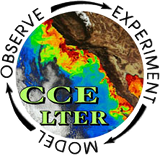 ©2020 Biological and Chemical Oceanography Data Management Office.
©2020 Biological and Chemical Oceanography Data Management Office.Funded by the U.S. National Science Foundation
NSF abstract:
The California Current System off the U.S. west coast includes a coastal upwelling region that is among the most productive ocean ecosystems within the U.S. Exclusive Economic Zone, and the world. This upwelling domain extends along the coasts of Washington, Oregon, and California. Many living marine resources develop in this region, which includes five National Marine Sanctuaries. Variability in ocean climate in this region directly and indirectly influences both harvested and protected marine populations, including numerous species of marine fishes, invertebrates, marine mammals, and seabirds. The California Current System is also important to drawdown of atmospheric carbon dioxide and carbon sequestration, due to the high primary productivity of the coastal ocean and processes that transfer carbon and other elements into deep ocean waters. Of sources of climate variability, El Niño is considered the largest climate signal on earth. It markedly influences many ocean populations, as well as modifying weather patterns across the United States. The current El Niño of 2015-16 has been characterized as a "strong" event by the U.S. Climate Prediction Center, and may become one of the strongest El Niños in recent history. In addition, this El Niño follows a sustained, unusual warming in the Northeast Pacific Ocean that began in 2014, and then intensified along the west coast of North America in 2015. The combination of these two ocean perturbations is expected to alter marine ecosystems in many ways. The purpose of the proposed research is to quantify the effects of El Niño on key processes acting on planktonic organisms at the base of the ocean food web, because responses of these organisms are fundamental to understanding and forecasting the effects of El Niño on higher order consumers in the food web. The Broader Impacts of this research include the provision of new quantitative understanding that will be incorporated into future forecast models of the effects of El Niño off the U.S. west coast. This improved understanding will aid in the management of key living marine resources. The research will involve numerous graduate students in at-sea science and aid in the training of the next generation of ocean scientists. The investigators will develop public programs and outreach efforts in collaboration with the Birch Aquarium at Scripps, including an Explore-It: Plankton! public program that will increase public awareness and understanding of El Niño effects on coastal pelagic communities. They will also develop a Science Exploration Adventure (SEA) Days program that will focus on the CCE El Niño response cruise, in order to connect visitors directly to the process of ocean research and careers in the ocean sciences. A RAPID response proposal is necessary because this El Niño will be of limited duration and there is insufficient time to submit a proposal through the regular process.
A 20-day research cruise will be conducted in the southern sector of the California Current Ecosystem, a region with an extensive series of baseline measurements against which the effects of El Niño can be compared. We will quantify the effects of El Niño on key rate processes that control the structure of the pelagic food web and control rates of elemental cycling. The processes measured will include primary and secondary production, grazing, dissolved iron effects on phytoplankton growth, carbon and nitrogen recycling, and elemental export in both particulate and dissolved forms. The measurement approach entails a Lagrangian (water parcel-tracking) study of a series of discrete water parcels that represent different subregions: the nearshore coastal upwelling region, the offshore wind-stress curl upwelling domain, the low salinity core flow of the California Current proper, and more stratified ocean conditions offshore. Measurements will be done by in situ incubations at multiple light depths, by simulated in situ incubations aboard ship, and by vertically stratified sampling in each discrete water parcel. These measurements will facilitate the development of quantitative forecast models that can be used to project ocean responses to future El Niños and perhaps other warming phenomena.

Principal Investigator: Mark D. Ohman
University of California-San Diego Scripps (UCSD-SIO)
Co-Principal Investigator: Katherine Barbeau
University of California-San Diego Scripps (UCSD-SIO)
Co-Principal Investigator: Ralf Goericke
University of California-San Diego Scripps (UCSD-SIO)
Co-Principal Investigator: Michael R. Landry
University of California-San Diego Scripps (UCSD-SIO)
Co-Principal Investigator: Arthur J. Miller
University of California-San Diego Scripps (UCSD-SIO)
Contact: Mark D. Ohman
University of California-San Diego Scripps (UCSD-SIO)
DMP_Ohman_et_al_OCE-1614359.pdf (49.16 KB)
07/26/2017